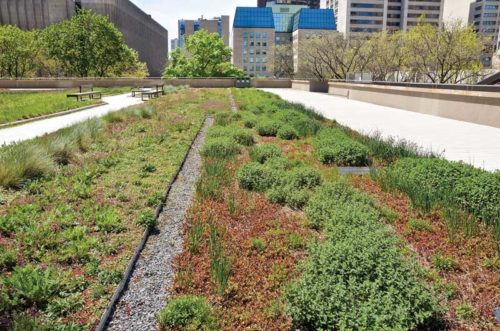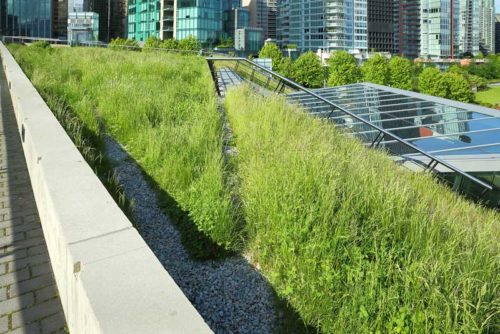Roof-top revolution: A sustainable approach
By Ryan Shure

With the federal government eyeing net-zero operations by 2050, all sectors of the economy are scrambling to improve their eco-friendliness and enhance sustainability. Sustainable construction is one of the most impactful steps businesses can take toward this end.
While many innovative materials and design principles can help improve a structure’s sustainability, one trending practice is the implementation of green roofs. For more on how rooftop gardens are being integrated into sustainable architectural designs, keep reading to explore green roofing solutions from different angles.
What are green roofs?
A green roof (a rooftop garden) is a layer of vegetation growing on the roof surface. There are two broad categories of green roofs: extensive and intensive.
Extensive green roofs are simpler and easier to maintain. They include hardy, climate-specific plants with shallow root depths that require little care to flourish. No major substrate renovations are required when installing an extensive green roof, although additional structural support may be required. In many cases, extensive green roofs are used to complement the existing roof surface and are not an all-expansive rooftop garden. Sections of grass or flowers surrounded by standard rooftop pavers could be considered an extensive green roof.
Intensive green roofs are more complex and far-reaching, ranging from complete rooftop gardens to fully accessible parks with trees and picnic areas. While awe-inspiring, they require more ongoing maintenance and a more robust roofing substrate. This is because they can add significant weight—ranging from 72.6 and 169.4 kg/m2 (160.06 and 373.46 lb/sf)1—due to the soil, vegetation, and water retention systems. Therefore, the structural support must be enhanced to accommodate these loads, including reinforcing beams and supports to ensure the building’s safety and compliance with local building codes.

Benefits of green roofs
There are a multitude of benefits to installing a green roof as part of a sustainable architectural infrastructure project.
Primary benefits include shade, leading to a reduction of rooftop temperatures, and removal of heat from the surrounding air. Research has indicated a 4 to 5 C (7 to 8 F) decrease in temperature directly from vegetated roofs.2
Further, green roofs feature a number of secondary benefits in their role of reducing the urban heat island effect. A few of the most pertinent include improved air quality, greater energy efficiency of the building, fewer greenhouse gas (GHG) emissions, improved human health and comfort, and effective stormwater management.
Anatomy of green roofs
There is a wide range of green roofing styles and layouts. Whether a green roof is extensive or intensive will determine the complexity of its design. However, the majority of green roofs will be composed of the following components:
Vegetation
This is the visible surface of the green roof. It consists of plants and vegetation, such as grass, flowers, shrubs, and/or trees.
Growing medium
For extensive green roofs, the recommended thickness of the growing medium is typically between 50 and 150 mm (1.97 and 5.91 in.). For intensive green roofs, which support a wider variety of plants, including shrubs and small trees, the growing medium needs to be significantly thicker, often ranging from 152 mm (6 in.) to several feet, depending on the design and intended vegetation.
Filter membrane
Typically a durable, lightweight fabric, this layer ensures the growing medium does not clog the drainage. However, it must be permeable to allow water that has passed through the growing medium to exit the roof.
Drainage layer
The drainage layer ensures adequate water flow off the roof. It directs water in a controlled manner that protects the roofing substrate while limiting erosion on the exterior of the building. In different climates, the drainage layer must handle large water volumes in heavy rainfall, resist frost, maintain effectiveness in cold climates, minimize water loss in arid regions, and be durable against local environmental factors while preventing erosion of the growing medium.

Root barrier
The root barrier prevents roots from breaking into the roofing substrate. Waterproofing the rooftop garden while upholding the roof’s structural integrity is essential.
Thermal insulation
Typically polyurethane or expanded polystyrene (EPS) foam, thermal insulation plays a crucial role in the success of a green roof. Not only does it help stabilize the interior conditions of the building, but it also helps regulate soil temperatures to promote the effective growth of rooftop vegetation in all seasons.
Vapour barrier
The vapour barrier helps reduce moisture transfer from the green roof into the building interior. This is especially relevant when cool roof conditions contrasted against warm interior temperatures create a breeding ground for condensation. It is an important component for limiting mould, mildew, rot, and other moisture-related problems from taking hold in the roof substrate.
Structural support
Intensive green roofs require more robust structural support than extensive green roofs and generally need additional load-bearing capacity beyond standard roofs. Structural engineers and roofing professionals recommend using steel beams and girders for maximum strength, though there are many materials and approaches available. B-decking or “B-deck”—a type of metal decking with a ribbed profile—provides shear support and transfers vertical loads horizontally to the building’s frame, enhancing both the strength and stability of the roofing system. In regions such as the West Coast, it is important to consider not just gravity load upgrades but also seismic requirements, which can often be more costly and even potentially halt projects.
Sustainable architecture with green roofs
Green roofs are popular in modern architecture for their sustainability benefits and ability to reduce urban heat islands. However, their installation can present challenges. Structural limitations can be addressed by conducting thorough assessments and reinforcing the building with steel beams and girders or other appropriate materials. Effective water management is crucial, which can be achieved by incorporating well-designed drainage layers suited to local conditions. Regular maintenance is needed to keep plants healthy and the system functional, which can be managed with routine inspections. Although the initial cost is high, long-term savings and increased building value can offset this. Proper plant selection is essential; consulting experts can ensure that plants suit the local climate and roof conditions. Addressing these challenges carefully allows green roofs to deliver their full environmental benefits.
Notes
1 For more information, refer to this document, publications.gc.ca/collections/collection_2016/schl-cmhc/NH18-26-4-2006-eng.pdf.
2 Review the research at www.sciencedirect.com/science/article/abs/pii/S0925857416303755.
Author
Ryan Shure is a freelance writer who loves sharing his knowledge and expertise on renovations and construction. He lives in Tampa, Fla., where he enjoys spending time with his wife and researching building material trends in his free time. Shure’s work as a freelance writer can be found on Building Product Advisor.








